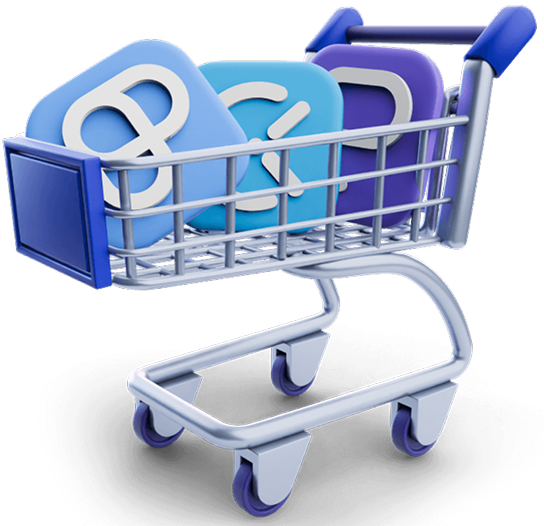Running a small business typically means juggling many tasks, and staying on top of customer relationships is key to long-term success.
Relying on software to help you with customer relationship management (CRM) is standard nowadays.
And it’s not just big companies that need a tool like this — small businesses benefit just as much from using CRM software to build stronger connections and boost sales.
There are quite a few options out there, so you might not be sure which route to take. That’s where my reviews come in — I’ve tested 10 proven CRM platforms, including some great budget-friendly solutions.
Whether you’re just starting or growing your business, this article will point you toward the CRM tool that best suits your needs. Let’s dive in!

In this article:
Top 10 CRM tools for a small business — overviews
Here’s a glance at all the apps I tested and reviewed. This is the basic info, while more detailed reviews, including pros and cons, are available in the following sections.
| Tool | Best for | Free trial | Free plan | Lowest price |
|---|---|---|---|---|
| Plaky | Low-cost CRM | ✔ | ✔ | $3.99/seat/month |
| HubSpot CRM | Email marketing | ✔ | ✔ | $15/seat/month |
| Zoho CRM | E-commerce | ✔ | ✔ | €14/user/month |
| Pipedrive | A small sales team | ✔ | ❌ | $14/seat/month |
| Freshsales | Communication with customers | ✔ | ✔ | $9/user/month |
| Freshdesk | Customer service | ✔ | ✔ | $15/agent/month |
| Less Annoying CRM | Ease of use | ✔ | ❌ | $15/user/month |
| Insightly CRM | Integrations | ✔ | ❌ | $29/user/month |
| monday CRM | Customizable workflows | ✔ | ❌ | $12/seat/month |
| Salesforce | Case management | ✔ | ❌ | $25/user/month |
How I chose and tested the CRM apps
Before diving into these comparisons, I wanted to make sure I wasn’t just repeating marketing claims. So, I rolled up my sleeves and tested each of these CRM tools myself.
While I don’t run a sales team or a traditional CRM-heavy business, I did my best to create mock workflows that mimic how a small business might manage leads, customer relationships, and internal collaboration.
The focus is on tools that have a solid reputation among small businesses and are either completely free or offer a free trial — because, let’s face it, most small teams can’t afford to commit to pricey software without knowing if it aligns with their needs.
Hopefully, these reviews save you time and guide you toward a tool that feels like a natural fit for the way you work.
#1 Plaky — best low-cost CRM tool
Plaky is an intuitive work management tool that will help you manage all customer-related activities like tracking leads, onboarding clients, and organizing support tasks.
Why choose Plaky?
Plaky’s visual layout, customizable boards, and team-focused features make it ideal for small businesses looking for a reliable yet affordable CRM solution.
| Plaky’s pros | Plaky’s cons |
|---|---|
| – Fully adaptable – Excellent free plan – Free sales & CRM templates – Project & task management features | – No dashboard – Limited automations |
I’ve been using this tool professionally for a while — admittedly, not for CRM purposes, but since I know how customizable Plaky is, I wasn’t surprised to see how well it can handle client-related tasks.
Here are Plaky’s most useful features for CRM:
- Flexible boards for customer pipelines — Create project boards fully tailored to your sales funnel or customer journey using Plaky’s versatile custom fields.
- Task tracking — Easily assign and track tasks related to specific clients or deals.
- Deadlines and priorities — Set deadlines and priority levels to ensure timely follow-ups and better organization.
- Sales & CRM templates — Use ready-made templates to save time and achieve consistency (e.g., contact list, customer inquiries, deals, and more).
Simplify CRM processes with Plaky

The only things that would make the CRM functionality even better are dashboards and additional automations (currently, only conditional coloring is available). Luckily, both are on Plaky’s roadmap of upcoming features, so stay tuned for that!
Now, what you’ll notice immediately is how well Plaky brings people together. It’s built around visibility and shared ownership — nobody’s left in the dark thanks to:
- Centralized client information — Keeping customer information and related files in one place enables faster, personalized service and reduces data duplication.
- Comments — Using comments and @mentions to ask questions or give updates directly within the relevant item (task) card eliminates the need for scattered email threads.
- Activity log — Maintaining a record of all changes made to each board and individual item minimizes errors and confusion.
- User roles & permissions — Ensuring the right level of access for each team member is crucial for simplifying workflows and improving security.
For a small team juggling multiple hats, this level of transparency and real-time project collaboration is a game-changer.
As a cherry on top, you can use Plaky for free! And if you want more advanced features, the paid plans are incredibly affordable, starting at only $3.99/seat a month.
💡Plaky Pro Tip
Learn how you can use Plaky’s potential to boost sales and inspire customer loyalty in our detailed guide:
What’s new in Plaky?
In addition to useful bug fixes, Plaky’s latest updates include the so-called CAKE.com account. Access 3 work management & productivity tools with a single login:
- Plaky — a project management app,
- Clockify — a time-tracking app, and
- Pumble — a business communication app.
Available for: web, iOS, Android
| Plaky’s plans | Plaky’s pricing |
|---|---|
| Free | ✓ |
| Pro | $3.99/seat/month* |
| Enterprise | $8.99/seat/month* |
*billed annually

#2 HubSpot CRM — best for email marketing
HubSpot is a popular CRM platform that offers a suite of marketing, sales, and customer service tools.
Why choose HubSpot CRM?
HubSpot CRM appeals to small businesses that want an all-in-one CRM solution, especially if they focus on email marketing, thanks to the tool’s robust features.
| HubSpot CRM’s pros | HubSpot CRM’s cons |
|---|---|
| – Neat design – Detailed contact/deal management – Great email marketing | – Slight learning curve – Limited number of emails in the free plan |
HubSpot has a user-friendly interface, so even businesses without dedicated IT teams can navigate it effectively with a little practice. Mastering automations and advanced features may take more time, though.
You can choose to import or create contacts, stating their names, emails, phone numbers, professional titles, etc.
Moreover, I like how detailed each contact entry can be, allowing for better organization and transparency by specifying:
- Deals — revenue-generating opportunities moving through different stages,
- Associated companies — contact-related businesses or organizations,
- Tickets — all your customer inquiries,
- Payment links — convenient links for one-time or recurring customer payments,
- Attachments — files providing helpful context, and more.
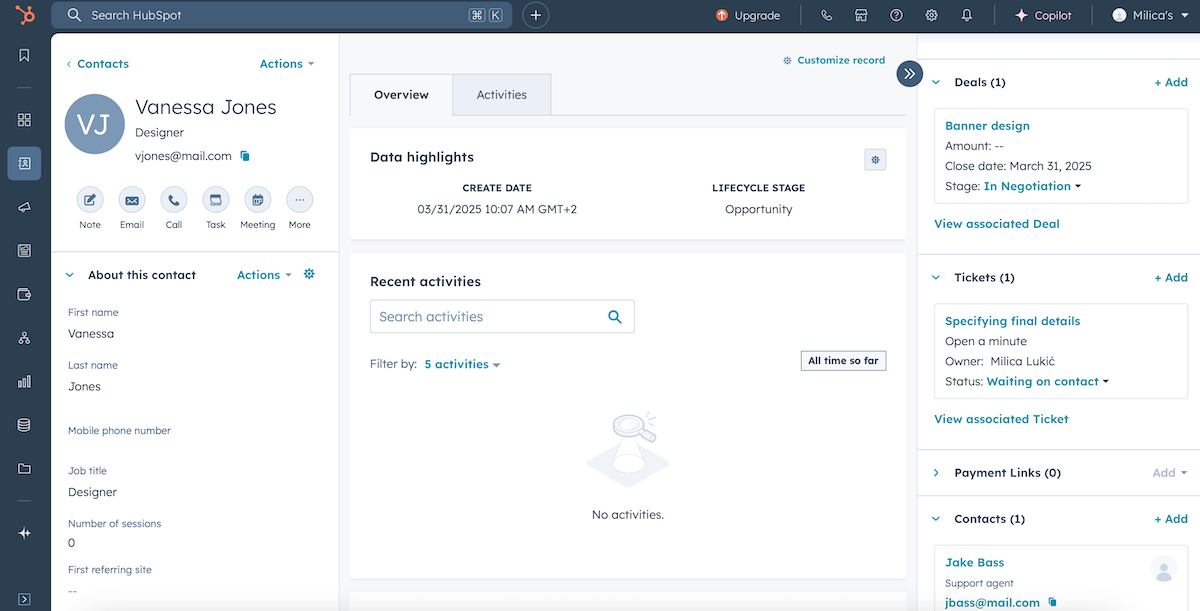
As for why I dubbed HubSpot the best tool for email marketing, it was thanks to these noteworthy features:
- Drag-and-drop email builder — Rely on various customizable templates to create professional emails without coding.
- Automation — Automate follow-up emails based on user actions.
- A/B testing & optimization — Test subject lines, content, and CTA buttons to enhance open and click-through rates.
- Integration with CRM & sales tools — Connect your email campaigns with sales pipelines to streamline your workflow.
While I appreciate that the email marketing feature is available in the free tier, I must emphasize that this plan has limitations. For instance, you have 2,000 emails per month and no automation/reporting features.
You’ll get those plus an email limit increase if you upgrade, but the higher plans are quite pricey. Obviously, this can be an issue for smaller budget–conscious teams.
What’s new in HubSpot CRM?
Not long ago, HubSpot unveiled Breeze, an AI engine designed to automate tasks and improve customer engagement scoring. Additionally, 70+ new apps joined HubSpot’s App Marketplace recently.
Available for: web, iOS, Android
| HubSpot’s plans | HubSpot’s pricing |
|---|---|
| Free | ✓ (up to 2 users) |
| Starter Customer Platform | $15/seat/month* |
| Professional Customer Platform | $1,300/month* (5 seats + additional seats start at $45/month) |
| Enterprise Customer Platform | $4,700/month (7 seats + additional seats start at $75/month) |
*billed annually
#3 Zoho CRM — best for e-commerce
Zoho CRM is cloud-based software designed to help you streamline sales, marketing, and customer support processes.
Why choose Zoho CRM?
Zoho CRM is known for its scalability and customization capabilities, making it a reasonable choice for small businesses, particularly e-commerce brands and startups.
| Zoho CRM’s pros | Zoho CRM’s cons |
|---|---|
| – Cost-effective – Numerous integrations – AI-powered predictive insights | – Most of the advanced features are locked behind a paywall – Large databases are slow to load |
This platform can assist you in:
- Contact management — Store customer details and interactions in one place for optimized organization.
- Lead management — Automate lead capture from emails, web forms, and social media.
- Sales pipeline & deal management — Use a visual pipeline to track deal details at different stages. Automate follow-ups, reminders, and deal closures.
- Reporting & analytics — Get dashboards with real-time insights to track sales trends and customer behavior with ease.
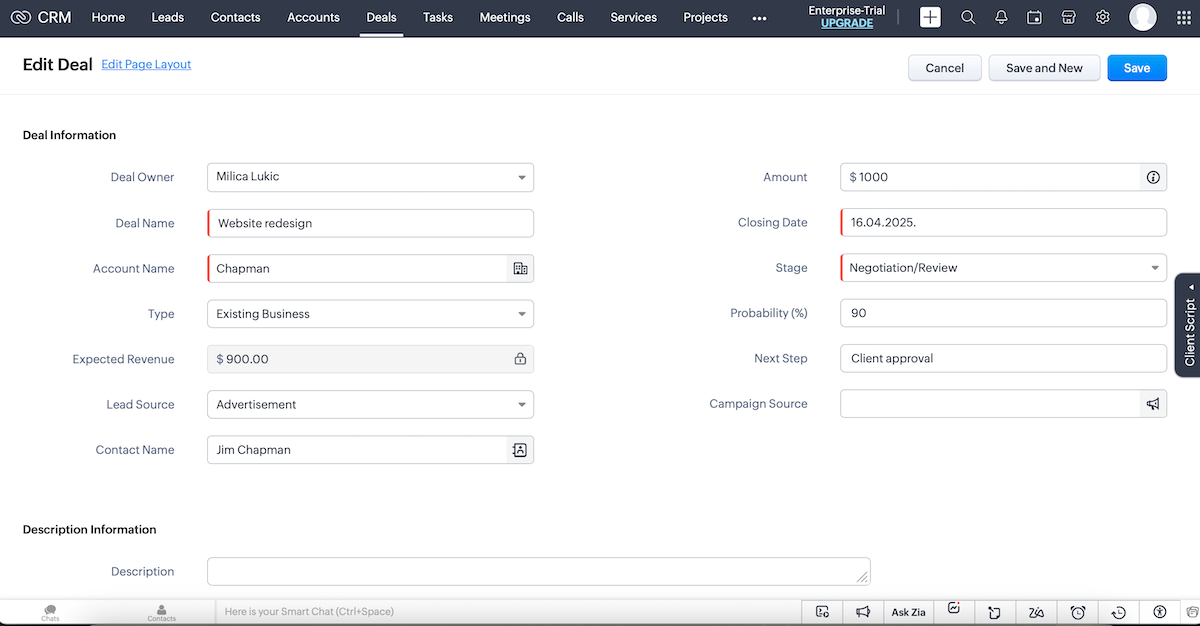
As you can see, Zoho CRM lets you create large databases, but a high volume of data sometimes means slow loading times. Also, the interface may lag when handling extensive automation workflows.
Back to the positives: this tool is a strong choice for e-commerce businesses if you consider the following:
- Integration with e-commerce platforms — Connect with Shopify, WooCommerce, and other similar platforms.
- AI-powered sales predictions — Use AI (so-called Zia) to predict customer behavior and optimize promotions.
- Inventory & order management — Integrate with Zoho Inventory for real-time stock tracking and monitoring shipping statuses.
- Cost-effectiveness & scalability — Use Zoho’s free version or move to one of the paid plans, which are considerably cheaper compared to some competitors.
If I could suggest something to make the free plan even better, it would be providing premium support to everyone, not just paid plan users.
You should also know that the AI assistant, advanced customization, and augmented analytics are locked behind a paywall as well.
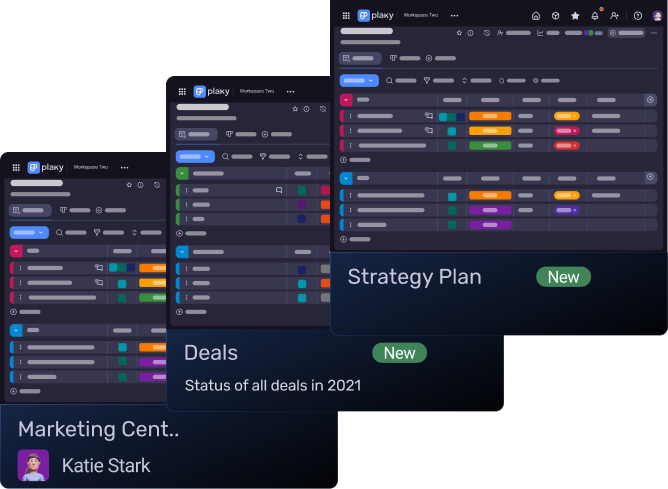
What’s new in Zoho CRM?
The latest Zoho CRM update included several enhancements and addressed a few crash scenarios. Also, the app recently introduced quick-view filters in reports, letting you add up to 5 filter criteria for greater flexibility in analyzing data.
Available for: web, iOS, Android
| Zoho CRM’s plans | Zoho CRM’s pricing |
|---|---|
| Free | ✓ (up to 3 users) |
| Standard | €14/user/month* |
| Professional | €23/user/month* |
| Enterprise | €40/user/month* |
| Ultimate | €52/user/month* |
*billed annually
#4 Pipedrive — best for a small sales team
Pipedrive is a sales-focused CRM tool that helps businesses track deals, follow up with leads, and close sales.
Why choose Pipedrive?
Pipeline is a decent choice for small businesses with a sales-driven focus because of its simple interface, automation, and pipeline management.
| Pipedrive’s pros | Pipedrive’s cons |
|---|---|
| – Simple UI and easy to use – 500+ integrations- Solid automations | – No free plan – Not suited for more complex workflows |
The first thing I noticed about this tool is the clean interface — no extensive training needed to start using it. And, since Pipedrive is specifically designed for sales project management, it isn’t cluttered with unnecessary features.
However, this also means that Pipedrive lacks robust email marketing and campaign management tools, so you might need to integrate with third-party tools for additional functionality.
Here are the CRM features worth mentioning:
- Drag-and-drop pipeline — Make deal tracking effortless by simply moving items across your screen.
- Lead & contact management — Capture leads from emails and web forms. Organize customer details, conversation history, and notes in one place.
- Task management — Schedule tasks, link them with specific deals or contacts, set deadlines and priorities, etc.
- Collaboration features — Share dashboards and reports with team members for better coordination.
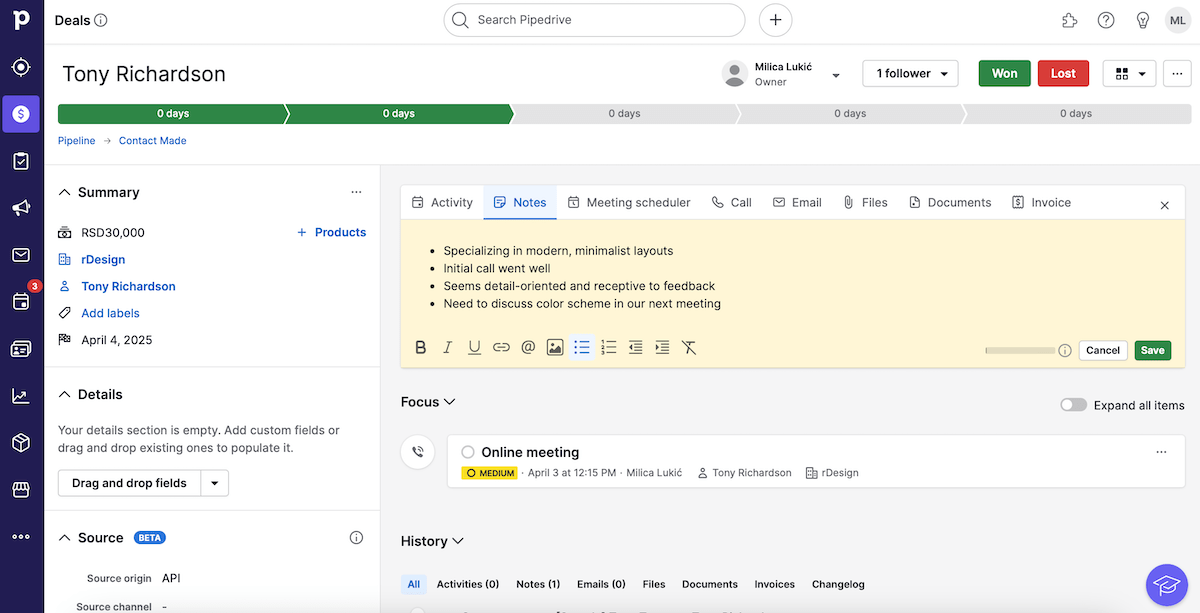
Furthermore, Pipedrive is particularly suitable for small sales teams because of its:
- Automation capabilities — Automating repetitive tasks means small teams can handle more leads with less effort.
- Scalability — Pipedrive has multiple tiers, so it can be easily scaled up if your team grows.
- 500+ integration options — Since many small teams can’t afford complex, all-in-one CRM tools, lightweight integrations mean additional flexibility and cost savings.
Now some drawbacks: while Pipedrive allows basic custom fields and workflows, it isn’t as flexible as Plaky or Zoho CRM, for example, when it comes to deep customization.
Also, Pipedrive offers only a free trial, not a free plan, which may be a dealbreaker for teams on an extra-tight budget.
What’s new in Pipedrive?
Pipedrive’s AI report generator is relatively new, letting you enter custom prompts or select from suggestions to create reports and analyze data. Moreover, there have been some minor improvements to Activities and Deals recently.
Available for: web, iOS, Android
| Pipedrive’s plans | Pipedrive’s pricing |
|---|---|
| Free | ❌ |
| Essential | $14/seat/month* |
| Advanced | $39/seat/month* |
| Professional | $49/seat/month* |
| Power | $64/seat/month* |
| Enterprise | $99/seat/month* |
*billed annually
#5 Freshsales — best for communication with customers
Freshsales is a CRM tool designed by Freshworks to help businesses streamline sales processes and collaborate easily within teams.
Why choose Freshsales?
With features like lead tracking, reporting, and integration with various communication tools, Freshsales can be particularly useful in communicating with prospects and customers.
| Freshsales’s pros | Freshsales’s cons |
|---|---|
| – Multi-channel communication – Intuitive design – Workflow automation | – Limited free/base plan – Basic reporting features |
These are the main CRM features in Freshsales:
- Capturing leads — Besides letting you manually add leads, Freshsales enables you to automatically capture leads from emails, websites, and social media.
- Custom fields — You can use various types of custom fields depending on what business data you want to store.
- Sales forecasting — Predicting future sales allows you to set realistic expectations and plan your budget and risk mitigation strategies accordingly.
- Workflow automation — Automating repetitive tasks reduces manual work and saves time.
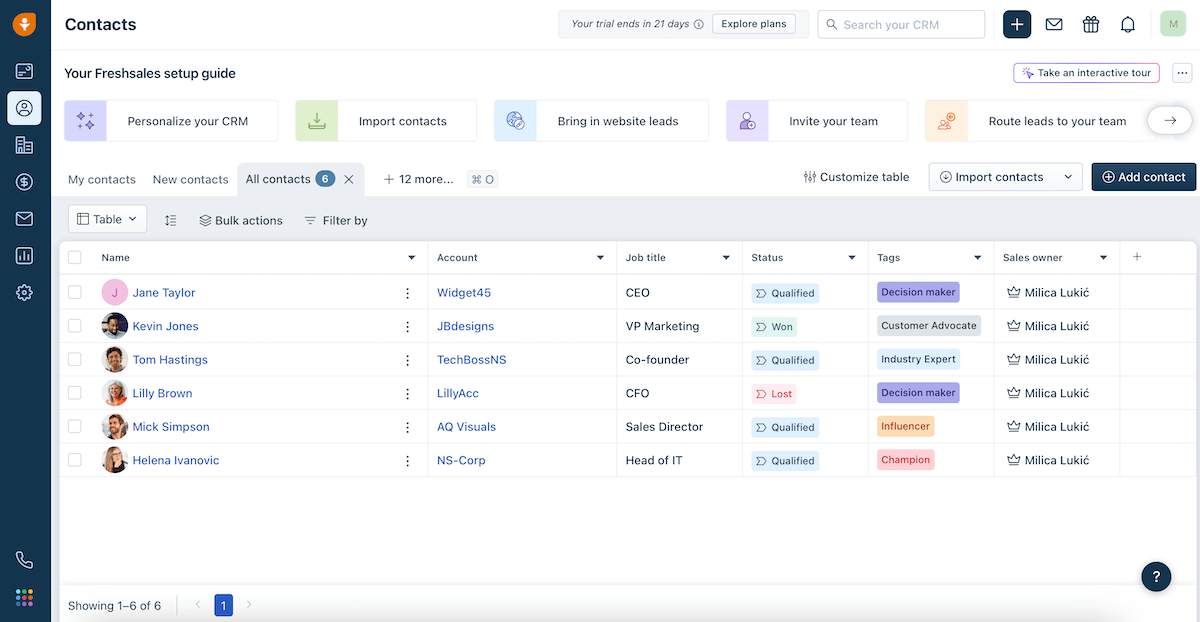
Freshsales also supports reporting and analytics, showing how many deals you’ve closed or how many leads are in your pipeline. However, businesses with complex needs might require more granular reporting or advanced customer behavior analyses.
As for why I believe this tool can enhance communication with customers, there are a few notable features:
- Multi-channel communication — Connect with customers through email and phone calls (within the system) or social media (via integrations). You don’t have to switch between apps to talk to your customers, which is convenient.
- 360° customer view — Get a comprehensive customer view with a timeline of all interactions, emails, calls, and notes. This supports contextual and personalized communication with customers.
- Built-in chat functionality — Besides the channels mentioned earlier, there’s an integration with Freshchat. This allows sales teams to live chat with website visitors or directly from the CRM tool.
I just wish that Freshsales had a less limiting free plan or that the Pro and Enterprise plans were more affordable. Some of the best features — automation, advanced reporting, and certain integrations — are only available in those higher-tier plans.
What’s new in Freshsales?
There haven’t been many Freshsales updates lately, but the available reports suggest the most recent enhancements refer to deal collaboration. For example, allowing teammates to tag each other on essential records is a novelty aimed at fostering alignment within sales teams.
Available for: web, iOS, Android
| Freshsales’s plans | Freshsales’s pricing |
|---|---|
| Free | ✓ (up to 3 users) |
| Growth | $9/user/month* |
| Pro | $39/user/month* |
| Enterprise | $59/user/month* |
*billed annually
#6 Freshdesk — best for customer service
As you may assume based on its name, Freshdesk is another tool by Freshworks. This one is cloud-based software offering various functionalities to refine CRM helpdesk operations.
Why choose Freshdesk?
With its advanced ticketing, automation, and collaboration features, Freshdesk can help you handle inquiries with ease and improve customer relationships.
| Freshdesk’s pros | Freshdesk’s cons |
|---|---|
| – Organized ticketing system – Multichannel support – Customer satisfaction tracking | – Limited customization – Expensive |
Here are some essential Freshdesk features:
- Ticketing system — Convert customer queries into trackable tickets so that no request is lost.
- Automation & AI — Use AI-powered chatbots and workflow automation to minimize manual work.
- Dashboard — Track ticket statuses, undelivered emails, to-dos, and more to help you monitor performance and KPIs.
As someone who had never used a customer engagement solution before this review, I found it very easy to navigate Freshdesk. The layout and the menus are neat and intuitive, which is a nice plus.
Setting up workflows and automations requires more learning time, though. It’s because you can automate different actions (such as triggering email notifications or assigning tickets) based on various parameters.
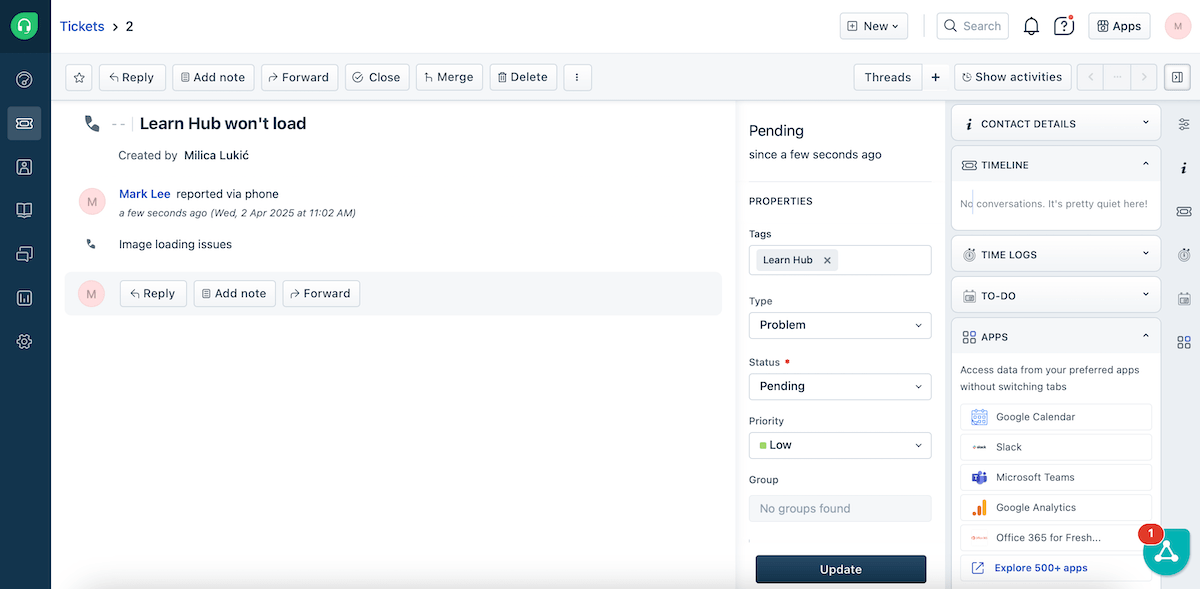
As for what makes this platform best for customer service activities, take a look at these features:
- Unified ticketing system — This ensures that every customer request is organized and prioritized.
- Multichannel support — Businesses can communicate with customers via email, chat, phone, and social media without switching platforms.
- Customer satisfaction tracking — The previously mentioned dashboard helps you measure and improve service quality through surveys and reports.
- Self-service portal — You can create portals where customers search your knowledge base and forums to find answers without contacting support.
If you’re wondering about some downsides, I’d say limited customization is the biggest one. The ticketing system, for instance, has a predefined structure that can’t be modified extensively.
Additionally, Freshdesk’s paid plans add notable costs for automation, AI, and omnichannel support. So, for very small teams or startups, the free plan might be too limited, and upgrading can become expensive fast.
What’s new in Freshdesk?
The latest enhancements in Freshdesk cover the ticket summary (for a more comprehensive overview of each ticket at a glance) and ticket list view (filtering tickets more effectively, performing bulk actions, and more).
Available for: web, iOS, Android
| Freshdesk’s plans | Freshdesk’s pricing |
|---|---|
| Free | ✓ (up to 2 agents) |
| Growth | $15/agent/month* |
| Pro | $49/agent/month* |
| Pro + AI Copilot | $78/agent/month* |
| Enterprise | $79/agent/month* |
*billed annually
#7 Less Annoying CRM — best for ease of use
Less Annoying CRM is a simple CRM tool designed with small and one-man businesses in mind. The aim is to make managing contacts and activities more effective.
Why choose Less Annoying CRM?
You should pick this tool if you prioritize user-friendliness above everything, as it provides a straightforward approach to managing contacts, leads, and tasks without unnecessary complexity.
| Less Annoying CRM’s pros | Less Annoying CRM’s cons |
|---|---|
| – Minimal learning curve – Task management features – Simple pricing structure | – No native mobile app – Might be too simple for some teams |
Less Annoying CRM is neatly organized into these sections:
- Contacts and companies — Make a database of your contacts, specifying their name, job title, email, phone number, and more.
- Calendar — Enter events (blocked-off periods) or tasks (checklists) into the calendar for enhanced planning.
- Workspace overview — See tasks that are due, upcoming events, recent activities, and leads in a single place.
- Reports — Use pipeline, activity, and task reports to visualize data and gain more comprehensive insights.
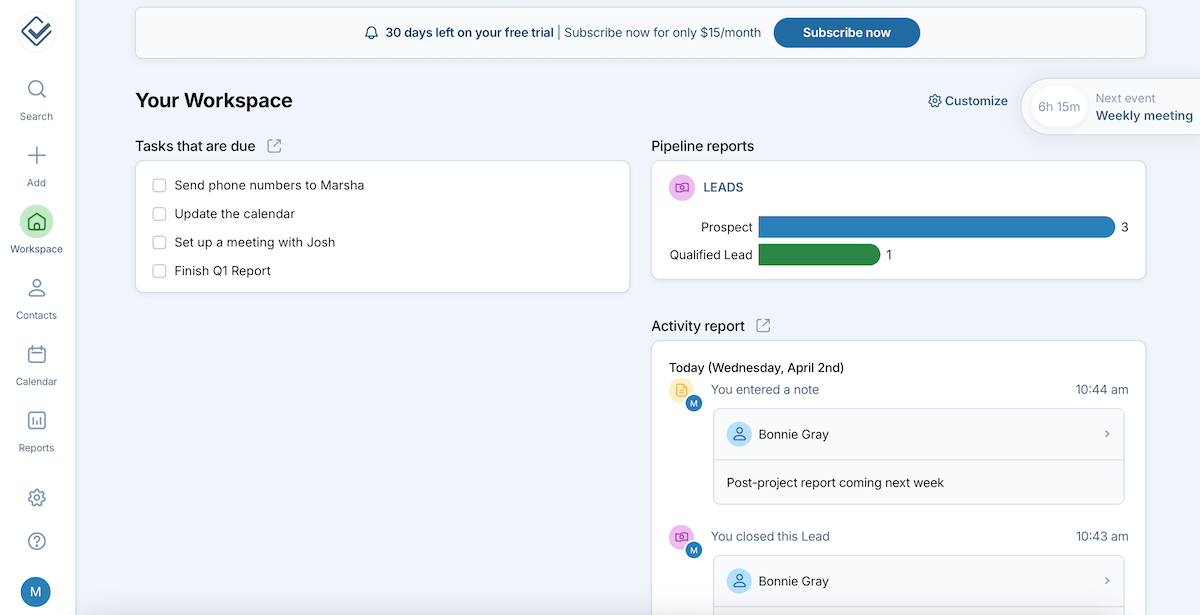
The best thing about Less Annoying CRM is how user-friendly it is — here’s why:
- Minimal learning curve — The platform is designed for non-technical users, with a clean interface.
- No overwhelming features — The focus is on essential CRM features.
- Quick setup — You can start managing contacts and sales within minutes without extensive onboarding.
- Simple pricing structure — There are no confusing add-ons or feature-based pricing; every user gets full access.
If you want simplicity, this is all great. However, if you need advanced automation, AI, or deeper reporting, you might find Less Annoying CRM limiting.
Also, if you plan to expand your business in the future, this tool might not be ideal later on — primarily because it lacks advanced features and integrations.
My final complaint has to do with the lack of a native mobile app since I like accessing my tasks on the go. That said, you can still use Less Annoying CRM via a browser on your phone, so it’s not a dealbreaker.
What’s new in Less Annoying CRM?
Less Annoying CRM has a new feature that allows automatic logging of emails to and from contacts already in the tool, streamlining communication tracking. Also, users can now color-code groups to facilitate quick visual organization.
Available for: web
| Less Annoying CRM’s plans | Less Annoying CRM’s pricing |
|---|---|
| Free | ❌ |
| Paid plan | $15/user/month |
#8 Insightly CRM — best for integrations
Insightly CRM is a software solution (mostly used by small to mid-sized businesses) that keeps your sales and customer data in a single place for improved management and productivity.
Why choose Insightly CRM?
Insightly combines CRM, project management, and automation into one platform, making it useful for teams that need to track sales leads, handle customer data, and execute projects all in one place.
| Insightly CRM’s pros | Insightly CRM’s cons |
|---|---|
| – 2,000+ integrations – Project & task management – Useful dashboards | – No free plan – Feels cluttered at times |
The first thing I did after launching this platform was explore the sidebar menu. Over there you’ll find:
- Tasks — a place for your to-dos, which you can conveniently link with contacts, organizations, opportunities, etc.,
- Contacts & leads — separate lists of contacts and leads with many useful fields (name and occupation, address, dates to remember, and so on),
- Dashboards & reporting — summarized info about your business’s progress overall,
- Time tracking — daily and weekly timesheets for enhanced productivity insights, and more.
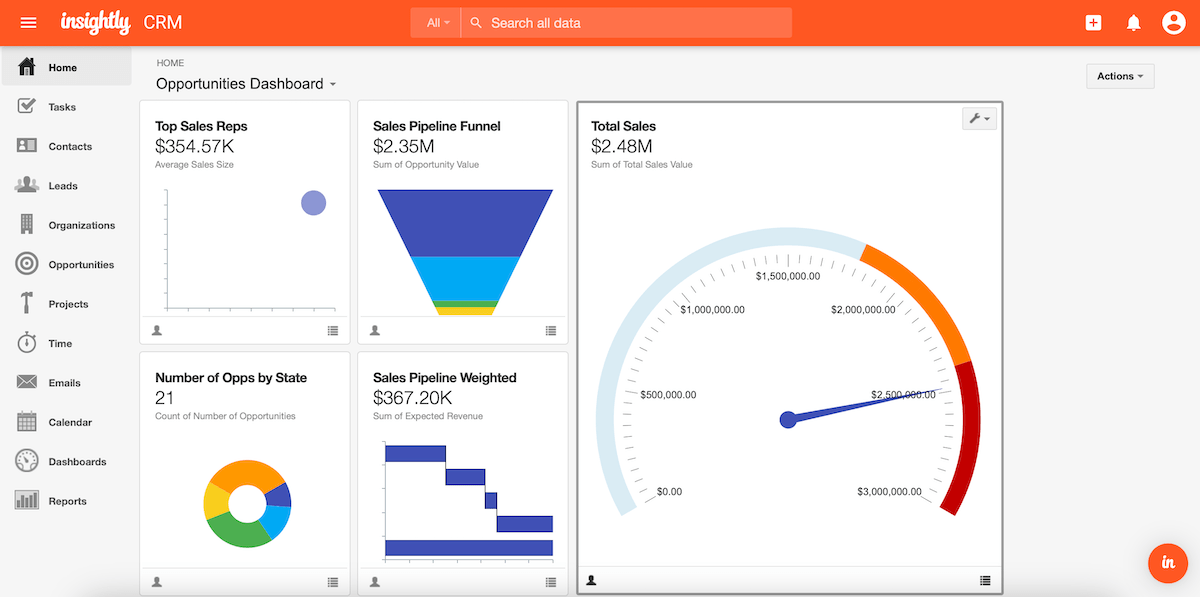
What impressed me the most about Insightly CRM is the fact that it supports 2,000+ integrations. This includes tools for:
- AI/machine learning,
- Collaboration,
- Sales and marketing,
- Finance and accounting,
- Human resources, etc.
What’s more, this platform provides an API that allows businesses to build custom connections with other tools and internal systems. This makes Insightly CRM highly adaptable for unique business needs.
All in all, this is a handy tool, but you should know that its project management features aren’t overly advanced. For example, Gantt charts in Insightly CRM are relatively simple compared to more PM-focused tools.
Another minus for me is the design. Of course, my dislike for the accent color is subjective, but I think other users would agree that the layout feels a bit cluttered with so many widgets and columns.
Lastly, there’s no free plan, and the paid ones are far from cheap, which poses problems for cost-conscious teams.
What’s new in Insightly CRM?
Insightly CRM now offers AI-powered smart replies. The creators claim it’s like having a dedicated assistant that helps you write professional and personalized emails fast.
Available for: web, iOS, Android, Gmail and Outlook sidebars
| Insightly CRM’s plans | Insightly CRM’s pricing |
|---|---|
| Free | ❌ |
| Plus | $29/user/month* |
| Professional | $49/user/month* |
| Enterprise | $99/user/month* |
*billed annually
#9 monday CRM — best for customizable workflows
monday CRM is a flexible CRM solution built on top of the popular monday.com work management platform. It’s designed to help businesses manage sales pipelines and customer interactions.
Why choose monday CRM?
Compared to most traditional CRM tools, monday CRM is much more customizable, meaning businesses can tailor the system to fit their unique workflows without needing technical skills.
| monday CRM’s pros | monday CRM’s cons |
|---|---|
| – Highly customizable – Useful automations – Detailed sales dashboard | – Can feel overwhelming at first – No free plan |
This platform helps small businesses with CRM by offering features for:
- Lead & contact management — Centralize all lead and client information for better consistency.
- Sales pipeline management — Track deals across stages using customizable boards to keep a close eye on your progress.
- Automations — Set up automation rules (e.g., “when a deal is marked won, assign onboarding task”) to save time and minimize errors.
- Sales dashboard — Get an overview of active deals, revenue (actual and forecasted), pipeline conversion rates, and more.
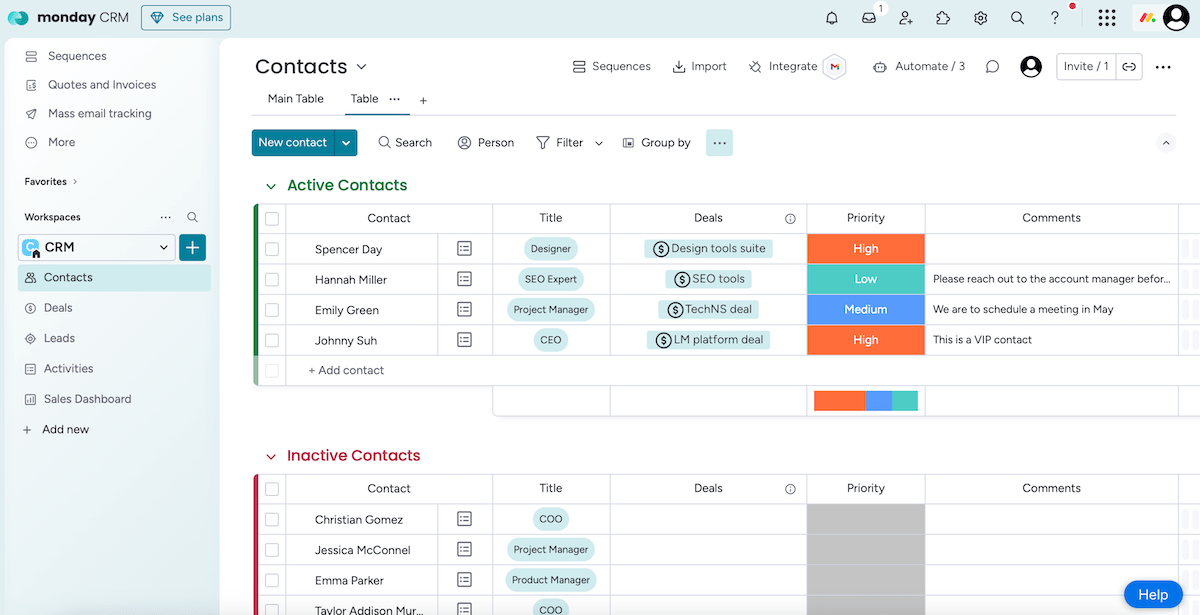
After trying monday CRM, what stood out to me the most was how easy it was to shape the entire system around my needs. Customizable workflows are possible thanks to:
- Drag-and-drop simplicity — No coding is needed; just build your own pipelines, stages, and fields using a visual interface.
- Flexible automations — You can automate repetitive actions based on triggers you define.
- Adaptable boards — Every aspect (columns, views, permissions, etc.) can be changed to support your unique sales cycle.
This means monday CRM can fit virtually any industry or process, which is a huge advantage. Admittedly, this flexibility can be daunting at first, so some small teams may find that setup takes time.
A bigger downside is the absence of a free plan. Plus, some of the best features (e.g., mass emails, invoicing, advanced analytics) are only available in the Pro and Enterprise tiers. As your team grows or starts needing more CRM-specific features, the cost adds up quickly.
What’s new in monday CRM?
You can now connect your Google or Outlook calendar to book meetings directly from monday CRM. The quotes & invoices feature is also new, enabling you to create, manage, and track financial documents seamlessly within the monday CRM workflow.
Available for: web, macOS, Windows, iOS, Android
| monday CRM’s plans | monday CRM’s pricing |
|---|---|
| Free | ❌ |
| Basic | $12/seat/month* |
| Standard | $17/seat/month* |
| Pro | $28/seat/month* |
| Enterprise | POA |
*billed annually, estimation for 10 seats
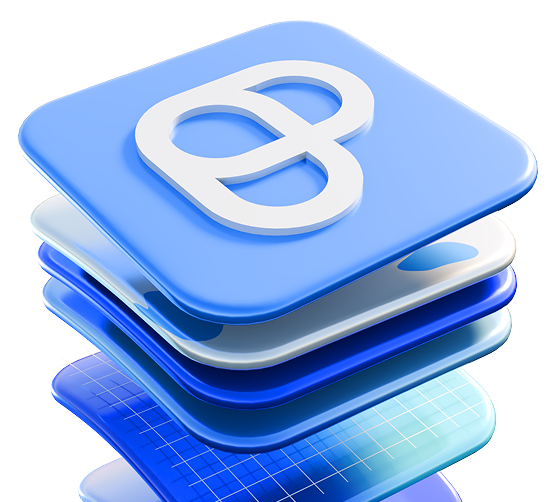
#10 Salesforce — best for case management
Salesforce is one of the most well-known CRM tools in the world. It allows businesses of all sizes to manage sales processes, marketing, and customer relationships in one centralized system.
Why choose Salesforce?
Salesforce is packed with features, but it stands out for case management, letting you resolve issues faster with smart automation and detailed histories.
| Salesforce CRM’s pros | Salesforce CRM’s cons |
|---|---|
| – Recognized globally – Automations – Robust reporting & analytics | – No free plan & high cost – Overkill for simple needs |
After diving into Salesforce, I quickly saw how it could transform the way small businesses approach CRM. Here are some of the most handy aspects:
- Contact & lead management — Track all interactions and segment leads to follow their progress through the sales funnel.
- Opportunity & deal tracking — Visualize and manage your pipeline/deal stages with precision.
- Generative canvas — Get key insights quickly by asking AI for a custom view of your information, with interactive charts and tables.
- Commerce tab — Manage your e-commerce operations within the Salesforce system by leveraging Salesforce Commerce Cloud (managing online stores, customer journeys, and product catalogs).
As you can see, Salesforce is powerful, but it might be too complex for smaller teams with straightforward CRM needs. Also, advanced customization may be difficult to navigate without a tech-savvy admin.
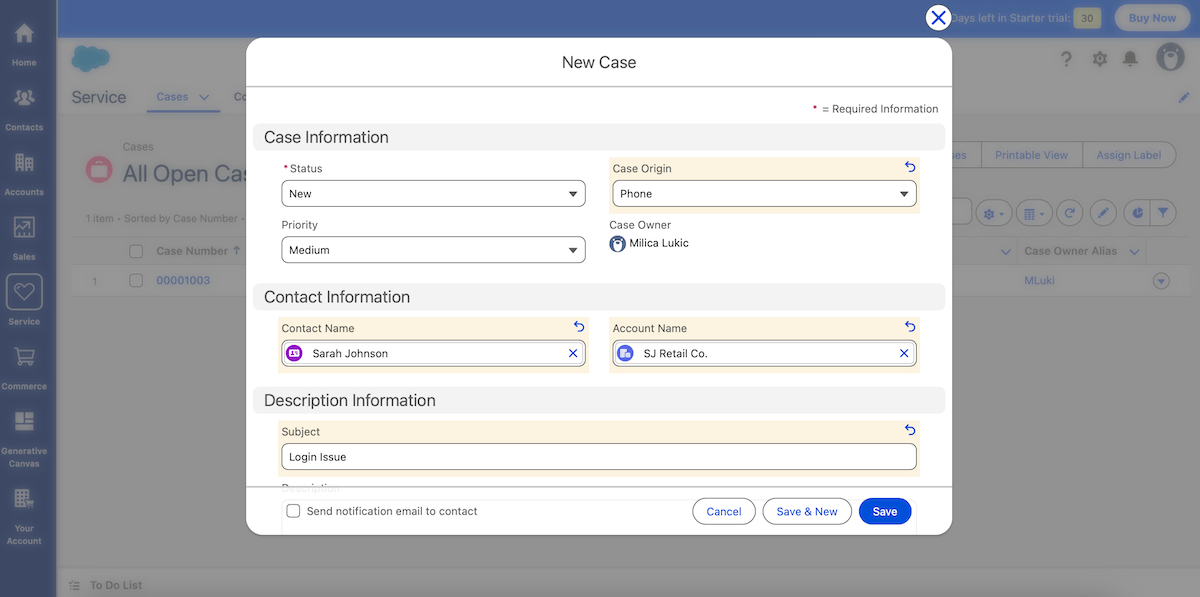
On a more positive note, having tested multiple CRM tools, I found Salesforce the most convenient for case management. It’s not just about tracking issues but resolving them more efficiently with:
- Robust case management features — Keep your case number, origin, status, etc. organized in a single place.
- Automated case assignment — Save time by automatically assigning cases to the right agent based on predefined rules (e.g., location, urgency, product type).
- Case histories — Check the complete record of changes made to each case to avoid confusion.
I would’ve ranked Salesforce higher on this list if it weren’t so expensive. The Starter Suite already requires $25 per user! And if you want greater customization and automation, be ready to set aside hundreds of dollars each month.
What’s new in Salesforce?
Salesforce has recently unveiled Agentforce 2.0, an advanced AI platform designed to automate digital tasks. In addition, the app has expanded the functionality for Shield Platform Encryption to bolster data protection measures.
Available for: web, iOS, Android
| Salesforce’s plans | Salesforce’s pricing |
|---|---|
| Free | ❌ |
| Starter Suite | $25/user/month* |
| Pro Suite | $100/user/month* |
| Enterprise | $165/user/month* |
| Unlimited | $330/user/month* |
| Einstein 1 Sales | $500/user/month* |
*billed annually
Benefits of using CRM software for a small business
Some of the key benefits of using CRM software to run a small business include:
- Stronger customer relationships — When you keep track of all customer interactions, you can provide personalized service and build loyalty.
- Better organization — With centralized customer data and sales opportunities, you make it easier for your team to stay organized.
- Improved sales & lead tracking — By staying on top of leads and sales processes, you ensure no opportunities slip through the cracks, and you boost conversion rates.
- Informed decision-making — Real-time data about your team’s performance and sales trends allows for smarter, more data-driven decisions.
How to choose CRM software for a small business
Truthfully speaking, no CRM software is ever going to be 100% perfect since each business has its own evolving needs and preferences. Nonetheless, with a bit of thinking and research, you can find a tool that checks most of your boxes.
Here are some questions to consider.
Does the price align with your budget?
When choosing a CRM solution, it’s essential to evaluate the pricing structure to ensure it matches your budget.
Many CRM tools offer tiered pricing, with different features available at different levels. As a small business, you’ll want to opt for a tool that fits your current budget but also allows for future growth.
Also, don’t forget to check for any hidden fees for additional features or users!
Does the CRM tool have the features you need?
One of the most important steps in choosing your CRM platform is assessing whether it has the core features your small business requires.
Ask yourself: do I need basic contact management or more advanced functionalities like automations or integrations with other tools?
Make sure the chosen tool provides a feature set that will streamline your processes and not just the ones that sound appealing!
How easy is the CRM tool to use?
Ease of use is an essential factor for many users, especially small teams that don’t have the time or resources for extensive training.
The best thing you can do is look for reviews like the ones I provide in this article or try a demo to gauge how simple it is to navigate and set up the CRM platform in question.
A tool that’s too complex may slow down your team’s productivity, so go for one that’s easy to understand and adopt across your activities.
How big is your team?
Consider the size of your team to ensure that the CRM tool suits your current setup and allows for future expansion.
A one-man business may benefit from simpler, cost-effective software, whereas having a team typically requires collaboration and communication features as well.
For a growing business, you’ll need a tool that can scale with your increasing needs. This way, you avoid the hassle of switching platforms as your business matures, saving time and effort in the long run.
💡Plaky Pro Tip
Are you a tired small business owner/team in need of a pick-me-up? Take a break and scroll through our inspiring compilation of quotes:
Enjoy seamless CRM with Plaky
A CRM tool is more than just a digital address book — it’s a powerful way to stay organized, enhance customer relationships, and help your small business grow.
The best CRM tool for your team is the one that supports your goals, fits your workflow, and doesn’t overwhelm you with redundant complexity.
That’s exactly where our platform, Plaky, shines. Its adaptability and affordability make it an ideal CRM tool for small businesses across industries.
What really sets Plaky apart is how user-friendly it is — you don’t have to be tech-savvy or have a background in CRM to use this app effectively. With its growing template center, getting started is even easier.
Plus, Plaky isn’t just for CRM — it doubles as a project management platform, so you can:
- Run your entire business from a single place,
- Visualize your data in 3 different project board views (Table, Kanban, and Gantt view),
- Take advantage of the real-time collaboration & notification features, and more.
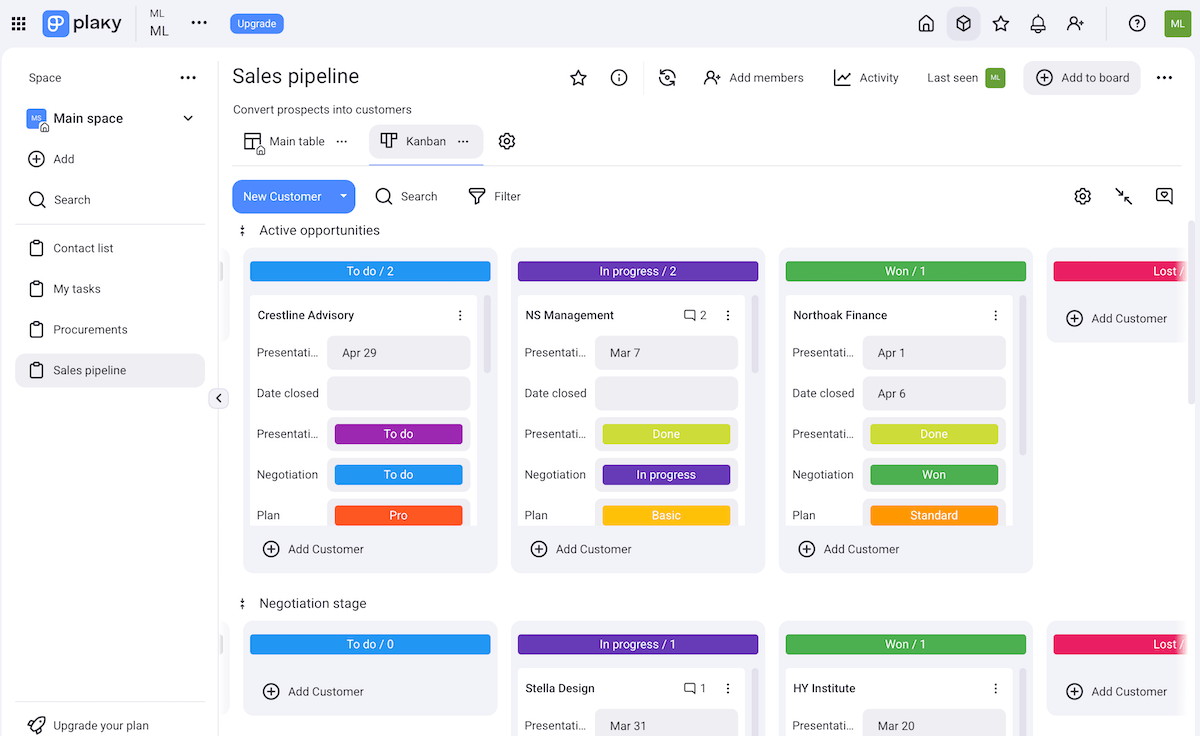
And since business often doesn’t stop when you’re away from your desk, Plaky also has mobile apps for iOS and Android users, letting you stay in control on the go.
Ready to simplify your CRM? Try Plaky today — it’s free, flexible, and perfect for growing businesses like yours!
